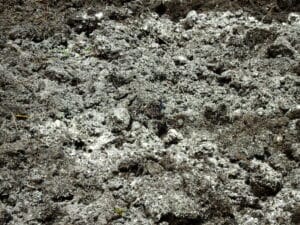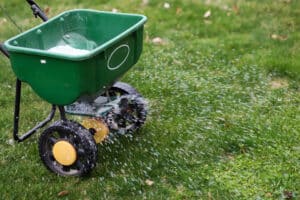Spring is your lawn’s wake-up call after winter’s dormancy, making it the prime time for a refresh. As both warm- and cool-season grasses begin to grow, proper lawn care sets the stage for a luscious landscape year-round. If you haven’t winterized or fertilized, spring is the time to address any bare patches or stunted growth before weeds take over.
You can tackle these tasks yourself, but using a professional lawn care service can be a smart investment. Professionals bring specialized skills and equipment to handle tasks like aeration and deep fertilization, which makes the DIY approach less daunting. Plus, a pro can offer customized treatment for stubborn issues. Here are 10 spring lawn care tips to consider to get your lawn thriving.
Get a Quote From Lawn Professionals Near You
Get a quote in as little as 5 minutes
Clicking “Get Your Estimate” submits your data to Home Service Quotes, which will process your data in accordance with the Home Service Quotes Privacy Policy.

Lime Soil Amendment

Lawn Fertilization
10 Essentials for Spring Lawn Care
Not all lawns will need all of the following tips every year. Some of these treatments may not work in tandem. Overseeding and applying herbicides at the same time can be counterproductive, for example. However, we’ve outlined them all so you can pick the seasonal lawn care tips that work best for your lawn.
1. Tune Up Your Mower
There’s nothing more frustrating than pulling out your lawn mower in the summer and struggling to get it to start up. Tuning up your mower goes beyond merely sharpening the blade—or replacing it, if it’s nicked too badly. You’ll need to change the oil, spark plug, and filter and fill the fuel tank.
2. Rake
To start with a clean slate, rake up any fallen leaves, general debris, and grass that may have died during winter. Be sure to rake when your soil is dry. If it’s too moist, you may pull up healthy grass.
3. Dethatch
This one is more of an as-needed chore, and its necessity will vary by the species of grass that you have. If the thatch—a layer of organic matter, made up of primarily dead grass, that sits between the top of your grass and its root system—is more than 1/2 inch thick, it’s time to remove it.
- Thatch creates a barrier, stopping your grass roots from getting the water, air, and nutrients they need to grow strong. If your thatch layer is too thick, it also makes your grass more vulnerable to disease, and may inspire insects to set up shop.
You can use a special dethatching rake to remove thatch if it’s too dense for your regular rake. Early spring is the ideal time to dethatch cool-season grasses, while you should wait for late spring if you’re caring for a warm-season lawn.
4. Aerate
If your lawn’s soil has become compacted, it’s time to break it up and give it room to breathe. Soil, especially clay-heavy soil, can become compacted from heavy foot traffic, making it too dense for water, air, and nutrients to reach the grass roots. In general, it’s best to aerate a cool-season lawn in the fall, but if necessary, you can do it in spring.
When you aerate your lawn, you introduce thousands of tiny holes into your soil, allowing water, air, and nutrients into your grass’s roots. You’ve got multiple options when it comes to aeration machines. Spike aerators use solid tines to perforate the ground. Plug aerators pull out a plug, or core, of grass and soil. A bonus of plug aerators is that you can let the core decompose on top of the grass, giving it more nutrients.
Quick Tip
- You can rent aerating machines or buy them, but purchasing them can be quite expensive. Professional lawn care companies like TruGreen have sophisticated equipment ready to aerate your lawn.
5. Test Your Soil
Lawns thrive with the proper soil acidity for optimum growth. The ideal soil pH for most plants ranges from 6 to 7—that’s slightly acidic to neutral. You can purchase a test kit at most gardening or hardware stores to test your soil’s pH, as well as its nutrient content.
Soil that is too acidic, that is, the pH is too low, can be treated with a lime amendment. This treatment adds powdered limestone to raise the soil’s pH. On the other hand, if your soil is too alkaline, you can add aluminum sulfate to lower the pH. Always test the soil first and apply these treatments according to the manufacturer’s instructions, since applying too much or at the wrong time can damage your grass.
6. Mow High
During this season, try not to take any shortcuts in an attempt to mow less frequently. Most lawns do their best at a grass height of 3–4 inches, so cut only 1/3 of the blades’ length at any one time. You should adjust your mower to cut at the highest setting for your grass type.
Short grass translates to shallow roots, making drought stress more likely. If you cut your grass too short, that lets too much sunlight in, making your lawn the perfect home for weeds. Tall grass, on the other hand, means deeper roots, which can compete with weeds.
7. Overseed
In general, overseeding should wait until late summer or early fall. However, if you want to fill in a few bare patches left by the cold weather, you can add seeds in the late spring. Since seeding mixes often contain starter fertilizer, don’t use them too early in the spring, when fertilizer can encourage growth that’s too fast for the climate.
Overseeding can thicken up your grass and return your lawn to its former, lush glory. Different types of turf builder seed mixes are suited to cool-season lawns and warm-season lawns, so check out the specific type when purchasing your blend. Use a hand spreader to distribute the seed.
- After overseeding, it’s essential to nurture your newly seeded grass for the first few weeks. Take extra care. Apply a slow-release fertilizer to help it grow hardy and healthy. Most grass seeds also need to be watered frequently in the first few weeks, unlike more established grass.
8. Kill Lawn Weeds
Spring weed control may call for pre-emergent and post-emergent herbicides. Pre-emergent herbicides kill weed seeds before they can germinate, but post-emergent herbicides kill weeds that have already grown. Make sure you’re using the correct type for the weeds that tend to grow in your lawn. Overseeding and applying pre-emergent herbicide conflict with one another, since the herbicide will halt the germination of new grass seeds, so keep these treatments separate.
If you’ve spotted weeds like dandelions on your springtime lawn, you can either pull them out by hand—an often tedious and not that effective task—or apply a post-emergent herbicide. You can apply post-emergent herbicides throughout the spring, summer, and early fall as weeds crop up, but take care. Some of these products can kill any plant they touch, so apply them cautiously.
9. Fertilize
Like overseeding, don’t fertilize your lawn if you’ve applied herbicides. If you haven’t, then slow-release, nitrogen-rich fertilizers are your lawn’s best friend. A top-quality fertilizer will nourish your lawn and help shield it against drought and heat. Just make sure to wait until the cold weather has truly passed.
Choose your fertilizer carefully, looking into the product’s NPK value, or the ratio of nitrogen to phosphorus and potassium. Nitrogen stimulates growth, while phosphorus encourages root growth, and potassium promotes flowering in plants. Conducting a soil test, as you did for acidity, will help you determine the best fertilizer for your grass type.
10. Eliminate Grubs
These pesky pests, which are pale, white, ravenous beetle larvae, feast on grass roots during spring and can hatch into beetles in the fall. Note that a healthy lawn can sustain some grubs without damage, but if you see more than five grubs per square foot, it may be time to take action.
You can combat grubs in a variety of ways. First, you can opt for traditional insecticides, which use synthetic chemicals to kill off these unwanted insects quickly.
Milky spore powder is a deadly snack for grubs. After a grub munches on milky spore, a naturally occurring bacteria, the spore reproduces inside of it, killing it from the inside out within three weeks. Neem oil is an organic pesticide that repels grubs and stops mature beetles from feeding and laying eggs.
- You can introduce beneficial nematodes to get rid of the grubs. These roundworms are a grub’s worst nightmare, as their gut contains beneficial bacteria that can kill off a grub. Keep in mind that these organic measures cost more and take longer to treat a whole infestation than their chemical-laden counterparts.
Professional Lawn Care
Now you have a good idea of all that goes into spring lawn care. If you’d like help with treatments like fertilizer, lime, and aeration, we recommend reaching out to TruGreen, an industry leader with decades of experience that’s available in all states except for Alaska and Hawaii.
TruGreen offers three core annual packages that tackle fertilization, aeration, weed control, and more. With these plans, a certified, highly trained TruGreen specialist will visit your lawn every four to six weeks to make sure it’s thriving.
If you’d prefer to go the DIY route, Sunday Lawn Care offers a customized series of products shipped straight to your door. The experts will determine which treatments work best for your type of grass in your climate, and you’ll apply them yourself. This takes the guesswork out of seasonal lawn care, even for those with lower budgets.
FAQs About Spring Lawn Care
What should I do to my lawn in spring?
Here are some lawn care tasks to do in the spring:
- Tune up your mower.
- Rake and dethatch the grass.
- Aerate compacted soil.
- Test the soil for nutrients and acidity.
- Mow high.
- Overseed as necessary.
- Eliminate weeds and grubs.
- Fertilize as necessary.
Should you rake dead grass in spring?
Yes, you should gently rake brown spots in cool-season lawns to remove dead grass, but wait until mid-spring when the grass has begun to green up again. If you rake too early, you may damage dormant but healthy grass.
How often should I water my lawn in the spring?
How often you should water your lawn depends on your climate. Typically, though, you’ll wait until mid-spring and give your lawn 1–1.5 inches of water a week.
Our Rating Methodology
Our team backs up our lawn recommendations with a detailed rating methodology that we use to objectively score each provider. We review lawn care plans and packages, navigate the provider website and speak with customer service representatives, request quotes, and analyze customer reviews for each provider. We then score the provider against our review standards for plan options, additional benefits and customizability, availability, trustworthiness, and customer service to arrive at a final score out of 100.






